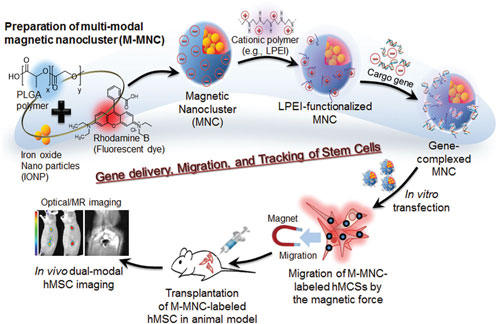| Posted: May 31, 2017 | |
New type of nanocomposite for stem cell therapy(Nanowerk News) In a new study published in Advanced Functional Materials ("Multimodal Magnetic Nanoclusters for Gene Delivery, Directed Migration, and Tracking of Stem Cells"), an international research team developed versatile magnetic nanoclusters (MNCs) capable of simultaneous gene delivery, direction of cell migration, and cell tracking for stem cell research. |
|
| For the purpose of stem cell differentiation, tracking, and migration, various nanoprobes, including magnetic nanoparticles, quantum dots, upconversion nanoparticles, gold nanoparticles, carbon nanotubes, and silicon nanoparticles already have been developed and applied to stem cells. Among these, magnetic nanoparticles have been of great interest because they can be utilized as magnetic resonance probes and respond to external magnetic fields. | |
| In their study, the team daveloped multimodal MNCs (M-MNCs) that are composed of a biocompatible PLGA polymer, ∼5 nm magnetic iron oxide nanoparticles, and fluorescent molecules (i.e., Rhodamine B), and were positively charged particles of ∼150 nm. | |
 |
|
| Schematic illustration of the preparation of multimodal magnetic nanoclusters (M-MNCs) and their applications in gene delivery and directed migration and tracking of stem cells. (Image: Wiley-VCH Verlag) (click on image to enlarge) | |
| In their in vitro studies, they found that the developed M-MNCs were easily internalized by stem cells through endocytosis. | |
| The M-MNC-labeled stem cells also migrated upon application of a magnetic field. | |
| Additionally, the researchers confirmed that the model gene GFP could be efficiently delivered to stem cells using M-MNCs. | |
| Finally, the stem cells labeled with these nanoparticles were successfully visualized in small animal models by both optical and magnetic resonance imaging. | |
| The authors conclude that the MNCs developed in their study have the potential to contribute greatly to stem cell research and cell therapy. |
 By
Michael
Berger
– Michael is author of three books by the Royal Society of Chemistry:
Nano-Society: Pushing the Boundaries of Technology,
Nanotechnology: The Future is Tiny, and
Nanoengineering: The Skills and Tools Making Technology Invisible
Copyright ©
Nanowerk LLC
By
Michael
Berger
– Michael is author of three books by the Royal Society of Chemistry:
Nano-Society: Pushing the Boundaries of Technology,
Nanotechnology: The Future is Tiny, and
Nanoengineering: The Skills and Tools Making Technology Invisible
Copyright ©
Nanowerk LLC
|
|
|
Subscribe to a free copy of one of our daily Nanowerk Newsletter Email Digests with a compilation of all of the day's news. |
